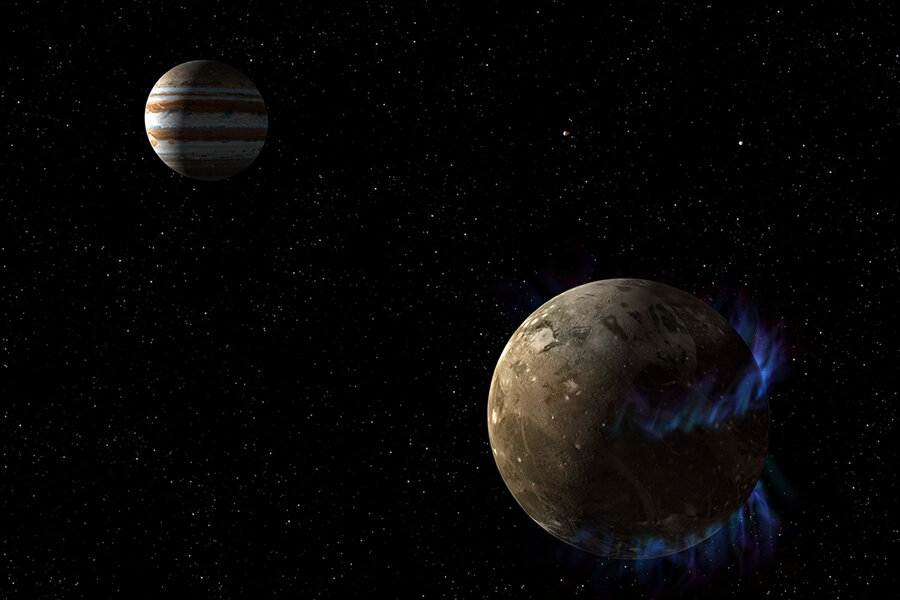Water, water everywhere in our solar system's moons
Loading...
The confirmation of a subterranean ocean underneath the icy surface of Jupiter’s moon Ganymede is the latest thread in a mounting body of evidence that water – and by theoretical extension, life – in our solar system need not be relegated solely to the narrow neither too hot nor too cold orbit known as the Goldilocks zone inhabited by Earth.
With this confirmation, announced Thursday by NASA, Ganymede joins the ranks of two other moons that lie beyond the reach of the sun’s warmth and are believed to host underground reservoirs of liquid water. Evidence of similar oceans has been detected on Europa, another of Jupiter’s moons, and Enceledus, which orbits Saturn.
This growing body of evidence that one of the key ingredients for life exists outside the range that was once considered to be the solar system’s only hospitable zone has prompted astronomers to completely rethink where and how they look for signs of life elsewhere in the solar system.
“One of the things that we have learned in the last few decades is that life as we know it is not as we know it,” says Nick Schneider, professor at the University of Colorado’s Department of Astrophysical and Planetary Science in Boulder, Colo.
While the quest for evidence of microbial life in the solar system may seem inconsequential to Earthlings, discovery of any form of life, however small, could hold profound clues about the origin of life on our own planet, says Dr. Schneider, who was not involved in the Ganymede research, but serves as the instrument lead on the Imaging UltraViolet Spectrograph for NASA's MAVEN mission to Mars.
“I think that people will really come to accept this as the most profound question that we can ask,” he says.
Astronomers first began to theorize that factors other than proximity to the sun could raise temperatures on other worlds to levels conducive to liquid water even before the first Voyager flybys around the Jupiter system in the 1980s, says planetary scientist Heidi Hammel, the executive vice president of the Association of Universities for Research in Astronomy (AURA) in Washington, D.C.
“What we’re learning is that the sun and its warmth isn’t the only way to get warmth in the solar system and we’ve been thinking that for some time,” Dr. Hammel says. “However, there’s a difference between having a theory about something and having evidence that the model is correct.”
Evidence confirming the presence of a subterranean ocean on Ganymede comes courtesy of NASA’s Hubble telescope and a new approach to analyzing its imagery pioneered by Joachim Saur, professor of geophysics at University of Cologne in Germany.
Dr. Saur’s approach focused on Ganymede’s aurorae, which are created by the mingling of Jupiter’ magnetic field with that of the moon’s. Ganymede – the largest moon in the solar system – is the only satellite large enough to house its own magnetic field.
“I was always brainstorming how we could use a telescope in other ways,” Professor Saur said in a NASA release Thursday. “Is there a way you could use a telescope to look inside a planetary body? Then I thought, the aurorae! Because aurorae are controlled by the magnetic field, if you observe the aurorae in an appropriate way, you learn something about the magnetic field. If you know the magnetic field, then you know something about the moon’s interior.”
Ganymede’s aurorae appear to rock back and forth as a result of fluctuations in Jupiter’s magnetic field. However, Saur found that the extent of that rocking appeared to be mitigated somehow and surmised that the presence of a salty ocean beneath the moon’s surface creates a secondary magnetic field that counters Jupiter’s, thus limiting the extent of fluctuations in the aurorae.
While this method of detection is indirect, it nevertheless provides valuable evidence that Ganymede houses not just water, but saltwater, says Chris McKay, an astrobiologist with NASA’s Ames Research Center in California’s Silicon Valley.
The presence of saltwater suggests that the ocean has, at least at some point in Ganymede’s history, come into contact with rock, Dr. McKay says in a message to the Monitor.
“The most important question is: ‘Is there an ocean?’ But following that, ‘Is this ocean connected to, communicating with, and reacting with rocks?’ ” he says. “And the presence of the conducting, salty nature of the ocean suggests that maybe the answer to that is yes, which would raise its level of interest for astrobiology considerably.”
That possibility is significant because water by itself cannot provide the necessary conditions for life, explains AURA’s Hammel.
“What you need is a mechanism by which chemistry can occur,” she says. “You need to have this solid surface in order to allow chemical interactions to take place. Ultimately, life is a chemical interaction.”
“When you put water in contact with a surface – like the hydrothermal vent that they think they just found on Enceladus – that complex chemistry can start happening in coordinated ways. You need to have a surface for that to happen,” she adds.
It’s those hydrothermal vents that McKay sees as most promising in the continued search for extraterrestrial microbial life, because they could make the ocean water accessible for sampling during future missions.








